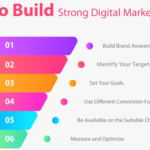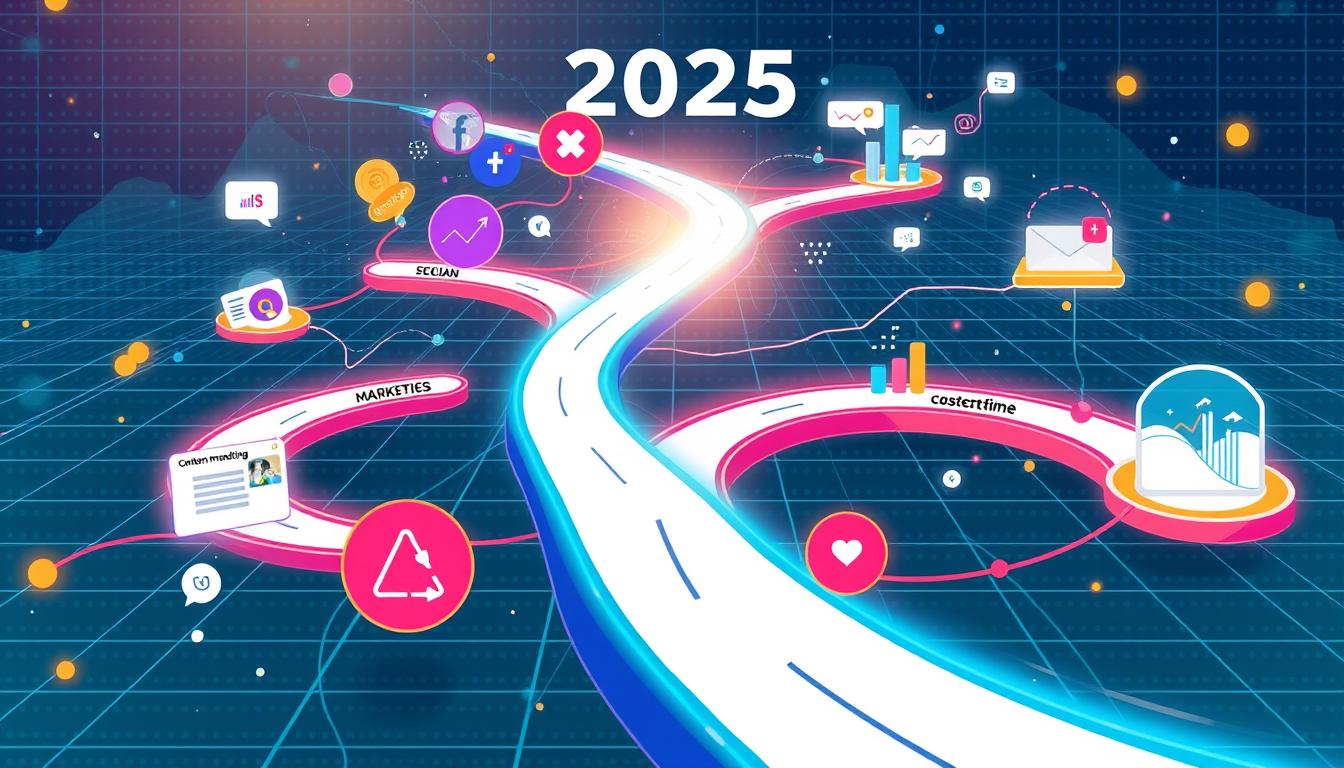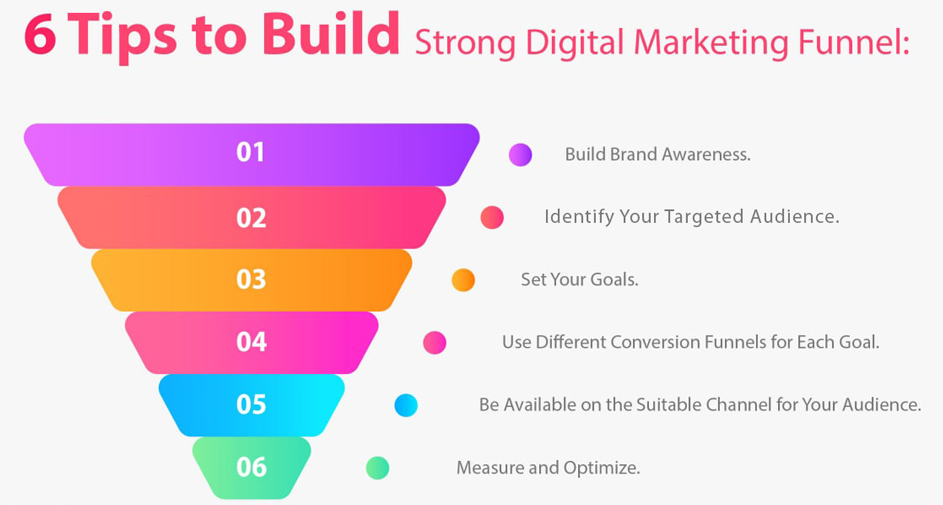
The Ultimate Digital Marketing Roadmap for 2025
The 2025 marketing trends will change how you market online. You’ll learn about new technologies and how to match your strategies with what consumers will want.
This guide is your key to success in the digital world. It helps you stay ahead and grow your business in a changing market.
Let’s dive into what makes a digital marketing strategy work in 2025. We’ll show you how to boost your online presence for long-term success.
Introduction to Digital Marketing in 2025
As we move towards 2025, having a strong digital marketing strategy is key. In today’s fast-changing online world, it’s vital for businesses to stay ahead. A good strategy helps you make an online marketing plan that really speaks to your audience.

Why Your Business Needs a Digital Marketing Strategy
A solid digital marketing strategy brings many benefits. It boosts your brand’s visibility, engages customers more, and can increase sales. By using digital channels, you can connect with your audience in a more personal way. This builds loyalty and helps turn visitors into customers. Plus, it keeps you in line with the latest market trends, letting you quickly adjust to changes and stay competitive.
Understanding the Digital Marketing Landscape in India
The Indian market trends are changing fast because of cultural, economic, and tech shifts. More people in India are going online, and they’re interacting with brands there. To succeed, businesses need to know what Indian customers like and how they behave. This means making your online marketing plan fit the Indian market better.
Let’s look at some key parts of a good digital marketing plan for India:
| Component | Description | Example |
|---|---|---|
| Social Media Engagement | Leveraging platforms like Facebook and Instagram to interact with the audience | Influencer collaborations and engaging content |
| Localized SEO | Optimizing content with local keywords and phrases | Using regional languages in blog posts |
| Mobile Optimization | Ensuring a seamless mobile browsing experience | Responsive design and fast-loading pages |
Setting Clear Objectives for Your Online Marketing Plan
Starting an online marketing plan means setting clear goals. These goals make sure your work matches your business objectives. They help you create a strong digital marketing strategy.
Defining Business Goals
It’s important to be specific and realistic when setting your business goals. First, figure out what you want to achieve with your marketing. Do you want to boost brand awareness, increase traffic, or improve customer engagement? Knowing your main goals will help you make a clear and focused plan.
- Identify the key areas of improvement or growth.
- Set specific, measurable, attainable, relevant, and time-bound (SMART) goals.
- Align your marketing efforts with overall company objectives to maintain consistency.
Measuring Success Metrics
After setting your goals, it’s key to know how to measure success with digital marketing KPIs. These indicators track your progress and help you adjust your strategy.
| KPI | Description | Significance |
|---|---|---|
| Website Traffic | Measures the number of visitors to your site | Indicates the overall effectiveness of your marketing efforts |
| Conversion Rate | Percentage of visitors who complete desired actions | Shows how well your website converts traffic into leads or sales |
| Social Media Engagement | Levels of interaction on social media platforms | Reflects the success of your social media strategy |
| Customer Lifetime Value (CLV) | Revenue generated by a customer over their lifetime | Helps in understanding the long-term value of your customer relationships |
By carefully defining your business objectives and using a detailed marketing roadmap, you can focus your efforts. This ensures measurable success in your digital marketing.
Identifying Your Target Audience
Knowing who buys your products is key for digital marketing success. Creating buyer personas and segmenting the market are vital for growth in 2025. This guide will show you how to find your customers, build detailed profiles, and segment the market well.

Creating Buyer Persona
Buyer persona are like detailed pictures of your ideal customers. They help you get to know your audience better. To make good buyer personas, you should:
- Gather demographic data like age, gender, job, and education.
- Collect psychographic insights, including interests, values, and lifestyle choices.
- Identify pain points and challenges your audience faces.
- Understand their buying behavior, decision-making process, and preferred ways to communicate.
By combining this info, you can make marketing messages that really speak to your audience.
Segmenting Your Market
Segmenting the market means breaking it down into smaller groups with similar traits. This makes your marketing more effective by letting you tailor your strategies for each group. Here are some ways to segment the market well:
- Demographic Segmentation: Grouping by age, gender, income, and more.
- Psychographic Segmentation: Dividing by lifestyle, values, and personality.
- Behavioral Segmentation: Segmenting by buying habits, usage rates, and brand loyalty.
- Geographic Segmentation: Grouping by location, like country, city, or neighborhood.
Here’s a quick look at the different ways to segment:
| Segmentation Type | Examples | Benefits |
|---|---|---|
| Demographic | Age, Gender, Income | Easy to do and gives basic info |
| Psychographic | Lifestyle, Values | Offers deep insights into consumer personalities |
| Behavioral | Buying Behavior, Brand Loyalty | Helps understand consumer’s buying habits |
| Geographic | Location, Region | Great for marketing in specific regions |
Using target audience identification and these segmentation strategies can improve your marketing. This leads to better customer acquisition and higher retention rates.
Choosing the Right Digital Marketing Channels
Picking the right digital marketing channels is key to your online success. You must know how to use each platform’s strengths to reach your audience. This guide will help you pick the best channels to boost your marketing ROI.
Social Media Marketing
Social media giants like Facebook, Instagram, and Twitter are vital for making your business more visible. They help you build strong connections with your audience and increase website traffic. It’s important to know where your audience hangs out and make content just for them.

Email Marketing
Email campaigns are a powerful way to talk directly to your audience. Whether it’s newsletters, deals, or personalized messages, email lets you connect with customers personally. To get the best results, sort your email list by what your customers like and do.
Content Marketing
A strong content strategy keeps your audience coming back for more. By making content that’s both useful and interesting, you meet your audience’s needs and boost your brand’s trust and search rankings. Use blogs, videos, infographics, and more to share value and spark interest.
| Channel | Primary Use | Best Practices |
|---|---|---|
| Social Media | Build Brand Awareness | Post Regularly, Engage with Followers |
| Email Marketing | Direct Customer Communication | Personalize, Segment Your List |
| Content Marketing | Provide Valuable Information | Create Quality Content, Optimize for SEO |
Leveraging SEO for Maximum Visibility
In the world of digital marketing, SEO optimization is key for boosting your brand’s online presence. Getting high search engine rankings is crucial for bringing valuable organic traffic to your site. As we move towards 2025, it’s important to know the latest SEO trends and best practices.
Creating a strong SEO strategy means looking at many different parts. Here are some key points to think about:
- Optimizing for voice search to reach users who use smart assistants like Amazon Alexa and Google Assistant.
- Using structured data and schema markup to help search engines understand your content better and boost your search engine rankings.
- Ensuring your site is mobile-friendly, since Google now prioritizes mobile-first indexing.

The core ideas of SEO optimization are still important. But, keeping up with trends like E-A-T (Expertise, Authoritativeness, Trustworthiness) from Google can make your brand more credible.
Let’s look at a comparison of old and new SEO methods:
| Aspect | Traditional SEO | Modern SEO |
|---|---|---|
| Focus | Keyword Density | User Intent |
| Optimization | On-Page Only | On-Page and Off-Page |
| Content | Quantity | Quality |
| Links | Basic Backlinks | Authority Backlinks |
By using these modern methods in your SEO optimization plan, you’ll not only get better search engine rankings. You’ll also draw a steady flow of organic traffic to your site. This will boost your brand awareness and help your business grow. Ready to increase your visibility? Start optimizing!
Crafting a Strong Content Marketing Strategy
To make a content marketing plan work, know what content your audience likes and the importance of a calendar. These elements help make content that grabs and keeps your readers’ attention.

Types of Content to Focus On
Having different types of content keeps your audience interested. It lets you meet various needs and tastes. Think about using:
- Blog Posts: Great for becoming an expert and getting more visitors.
- Videos: Catchy content that shares messages quickly.
- Infographics: Easy-to-understand visuals that simplify complex info.
- eBooks: Detailed content that acts as a go-to resource.
- Social Media Posts: Fast, fun content that boosts interaction and brand visibility.
Creating a Content Calendar
An editorial calendar is key for keeping up with a posting schedule and sticking to your plan. Here’s how to make a good content calendar:
- Identify Key Dates: Note important dates and events for your field or audience.
- Plan Content Themes: Choose monthly or weekly themes to organize and focus your content.
- Schedule Regular Posts: Pick how often to post to keep people interested.
- Assign Tasks: Share tasks among team members to make creating and sharing content smoother.
- Monitor and Adjust: Check your calendar’s success and tweak it as needed for better results.
Using these steps in your content marketing plan helps you make content that speaks to your audience and keeps them coming back. A calendar makes sure you’re always sharing top-notch content. This makes your strategy stronger and easier to handle.
The Importance of Mobile Optimization
In today’s fast-paced digital world, making sure your website works well on mobile devices is key. It’s not just a nice-to-have; it’s a must. Mobile optimization is vital for a better user experience and better search engine rankings.

Responsive Web Design
Responsive design is a key part of making your site mobile-friendly. It makes your website change size to fit different screens. This means everyone, from smartphone users to desktop users, gets a great experience.
Responsive design makes reading and moving around your site easy. It also makes users happy, which can lead to more people sticking around and doing what you want them to do.
Accelerated Mobile Pages (AMP)
AMP technology is all about making mobile web pages load super fast. It cuts down on unnecessary content to make pages load quicker. This is great for mobile users and can help your site show up higher in search results.
Google likes fast-loading pages on mobile, so this can help your SEO. Plus, it keeps users from leaving your site because it takes too long to load.
Putting effort into responsive design and AMP is a smart move for mobile optimization. These methods help your content work well on all devices. This is crucial for staying ahead in the digital world.
Utilizing Data and Analytics to Drive Decisions
Using data-driven marketing is key for businesses to grow their online strategies. By tapping into analytics in digital marketing, you can get valuable customer insights. This helps make your marketing better and guides your big decisions.

Data is powerful because it reveals habits that might be hard to see otherwise. With the right analytics tools, you can change how you make marketing choices. Tools like Google Analytics, Facebook Insights, and HubSpot give you detailed info. This info helps you understand what your customers like.
Here’s a quick look at various tools that can aid in data collection and analysis:
| Tool | Primary Use | Key Metric |
|---|---|---|
| Google Analytics | Website Performance | Session, Page views, Bounce Rate |
| Facebook Insights | Social Media Engagement | Post Reach, Engagement Rate |
| HubSpot | Lead Generation | Conversion Rate, Lead Attribution |
By adding these tools to your marketing plan, you can get important customer insights. This lets you:
- Find out what content and channels work best
- Improve how you target your audience
- Make the customer experience better
In conclusion, using data-driven marketing improves your decision-making. It also leads to a more tailored and successful marketing approach.
Enhancing User Experience (UX) on Your Digital Platforms
Making your user experience better is key to keeping and drawing in customers. Making your interfaces easy to use and understand can greatly increase how happy users are and how much they interact with your digital spaces.

Design Principles for Superior UX
Following main UX principles makes sure your users have a smooth and fun time. Here are some important tips:
- Consistency: Keep design elements the same on all pages to not confuse users.
- Simplicity: Easy-to-understand interfaces with clear content make it easy to navigate.
- Accessibility: Make sure your platform works for people with different abilities by adding accessibility features.
- Feedback: Give users feedback right away for their actions to keep them engaged and reduce mistakes.
Testing and Feedback Loop
Doing usability testing often is key to finding and fixing problems in your digital platforms. Here’s how to set up a good testing and feedback loop:
- Conduct Usability Tests: Test your platform with real users to see how they interact and what they find hard.
- Collect Feedback: Use surveys, interviews, and data to get lots of feedback from users.
- Analyze and Iterate: Look at the feedback to decide what changes to make and keep improving the user experience design.
- Implement Improvements: Make the changes based on what you learned to make UX better.
By focusing on these UX principles and keeping up with testing and feedback, your digital platforms can give an amazing user experience. This leads to more satisfaction and loyalty from your audience.
Aligning Your Digital Marketing Strategy with Trends and Innovations
it’s key to keep your digital marketing strategy fresh. This means keeping up with new marketing trends and tech. By always watching for what’s new, you can make sure your marketing stays strong and effective.

Think about making a strategy that can quickly change with new trends. This way, your messages will hit home with your audience and use the newest tools and platforms.
- Track trends: Keep an eye on industry reports from places like eMarketer and Gartner to know what’s new in marketing.
- Invest in training: Make sure your team knows about the latest in digital innovation through ongoing learning and getting certified.
- Leverage AI and automation: Use AI tools for marketing that’s more personal and automated to make things easier and more efficient.
It’s also key to watch how people are changing their ways. For example, more people are using mobile and voice search. So, your strategy should focus on these areas too.
| Trend | Application |
|---|---|
| AI and Machine Learning | Personalized content and predictive analytics |
| Voice Search | Optimizing content for voice queries |
Having a digital marketing strategy that’s in tune with innovation will help you make the most of new tech. It also leads to stronger engagement and better results in a world that’s always changing.
Digital Marketing Roadmap: Steps to Implementation
Starting your marketing journey needs careful planning and execution. A clear digital marketing roadmap ensures your strategy works well and reaches its goals. This guide will help you use your resources well, plan your budget, and set a timeline.
Allocating Resources and Budget
It’s key to allocate your marketing budget wisely for the best results. First, look at what resources you have and plan your strategy. Think about both people and money you’ll need for your digital marketing.
Next, divide your budget into parts like:
- Content production
- Paid advertising
- SEO and analytics tools
- Social media management
- Training and development

Creating an Actionable Timeline
A timeline keeps your digital marketing efforts organized. Start by setting goals for short, mid, and long terms. Then, turn these goals into smaller tasks for each month or quarter.
| Time Frame | Objectives | Key Actions | Resources |
|---|---|---|---|
| Month 1-3 | Set up foundational elements |
| SEO tools, content team |
| Month 4-6 | Launch targeted campaigns |
| Advertising budget, social media team |
| Month 7-12 | Measure and optimize |
| Analytics tools, marketing team |
Follow your roadmap and check your progress to make sure your planning is effective. Adjust your timeline as needed to hit your digital marketing goals.
Conclusion
Starting a marketing roadmap for success means having a detailed plan. This plan uses the digital world fully. By setting clear goals and measuring success, you make sure your strategy meets your aims. This ensures every action moves you closer to marketing greatness.
Finding your audience and choosing the right digital channels are key. Adding SEO helps your content be seen by more people. With a strong content strategy and making your site mobile-friendly, your message gets to the right people at the right time.
Using data and analytics to make decisions is crucial. Focusing on a good user experience and keeping up with trends and innovations strengthens your digital strategy. This approach is not just for now but for long-term success.
As you go forward, always check and adjust based on data. With this roadmap, you’re ready to reach marketing excellence. You’ll take your business to new heights in India’s competitive market in 2025.
Share this content:


















































1 comment